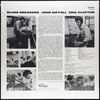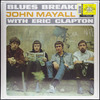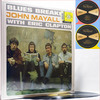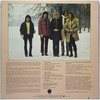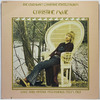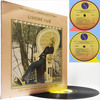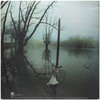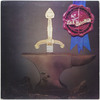Year:
1967 (CD 2001)Label:
SUNDAZED Records (USA), SC 6174Style:
Rock, PsychedeliaCountry:
Los Angeles, California, USTime:
39:10Format:
Flac Tracks 16/44,1 kHzSize:
225 MbContributor: Dave Stephens
With a stupid name like that it was always pretty unlikely that it would work out right for the band.
Couple in the fact that the band’s leader saw himself as the incarnation of hip/alternate, and …
… that the guy who’s reputed to have put the key components of the band together, Kim Fowley, while having a deserved cult following, has never been strongly associated with serious music,
then it might come as a surprise to learn that The West Coast Pop Art Experimental Band managed to release six albums, some of which contained some really good music.
There were two parts to the jigsaw. The first part was Bob Markley, adopted son of a wealthy oil magnate. Bob had studied law, which was to come in useful, but he was also an aspiring record star – he’d released a couple of singles on his own label. The other part was an existing band, the Laughing Wind, who’d also cut a few singles. The band comprised brothers Danny and Shaun Harris, on lead and bass guitar respectively, Michael Lloyd also on guitar, plus John Ware, drums. All bar Ware handled vocals. Most of the boys had worked in previous bands in the L.A. area.
At a party held in Markley’s Beverly Hills mansion in August 1965, attended by the Harris Brothers, Michael Lloyd, Kim Fowley and plenty more, with musical entertainment provided by the Yardbirds amongst others, our hero/anti-hero had one of those eureka moments and decided that groups were the in thing, and, armed with the introduction from Fowley, proposed to the Laughing Wind that, if he could join the group as vocalist and songwriter, he would purchase new gear for them plus a light show and would cover the boys’ touring expenses. This was agreed and Markley came up with the West Coast Pop Art Experimental Band name. Not only that, he ensured that legally he owned the band’s name and that he handled the music publishing.
The first album from the WCPAEB, released on the tiny indie FiFo Records (see Footnotes) was titled West Coast Pop Art Experimental Band Volume One, perhaps rather optimistically, since it implied a future. Without wishing to be unduly cruel, there wasn’t a lot on the album that signified there might have been a future. Much of it was garage in sound – this was 1966 – but slightly more tender in nature than some bands that got classified under that heading. Outside of five originals which I’ll come on to, the content consisted of covers, some predictable like You Really Got Me and yet another Louie Louie, some rather less predictable including Chris Kenner’s New Orleans rolling rocker Something You Got (a not unpleasing workout which did capture some of the Crescent City laid-back feel) and Oscar Brown/Nat Adderley’s Work Song. Unlike the Georgie Fame vocal version of the song which might have been a Brit source, this take was purely instrumental, in line with the Cannonball Adderley record.
There were two Dylan covers, It’s All Over Now Baby Blue and She Belongs To Me. The first was reasonable but paled in comparison to the versions from Them and the 13th Floor Elevators (with the last named taking the biscuit for sheer freakiness). However the WCPAEB’s version of She Belongs To Me definitely warrants a listen. Starting out with heavy fuzz bass, the record eventually disappears in a storm of feedback and distortion. In comparison, the vocal, which lasts for little more than a minute, is precise and controlled, sounding passably like Dylan without falling into the trap of pastiche. The whole thing is over in less than two minutes though one could well imagine them stretching out on stage.
Of the five originals, three were from Bob Markley with two being Kim Fowley co-writes. Two of this trio were unremarkable attempts at psych, while the other was a soft folk rock thing, not unlike the sort of song P.F. Sloan was producing in the time frame. Which leaves two, I Won’t Hurt You (on which Markley gets another co-write along with Shaun Harris and Michael Lloyd), and If You Want This Love. Both were decent folk rock sounding affairs which was probably why they were selected to turn up again on the group’s second album in more fully realised versions.
Before leaving this set I would note that, for many years the LP was very difficult to get hold of (which didn’t do any harm to the band in terms of cult status), but in 1997 a CD version was released via Sundazed which doubled the number of tracks to 22. It is believed that most, possibly all, of the extra tracks were from the Laughing Wind prior to morphing into the WCPAEB. Certainly they are generally softer in nature with more of an emphasis on harmonies. Their cover of the Left Banke’s She May Call You Up Tonight would illustrate this superbly if only it was on YouTube!
One gets the impression that Markley, who very much saw himself as leader with the rest almost as paid employees, was keen to expunge any memory of the first album, since the second, which saw release on the far more prestigious Reprise label, was entitled The West Coast Pop Art Experimental Band Part One. I would assume that it was only ‘Part One’ rather than ‘Volume One’ because the latter had been used. Whatever, Markley, with or without the band, evidently saw this as the start and given his general outlook that would probably have been, in his eyes, “the start of something big”.
It wasn’t – the start of something big that is – but it was a mighty fine album in its own right. From the first few bars of track #1, Shifting Sands, you were aware that this was on a different level to the first outing. There was a balance of eight relatively conventional, often Byrds inspired songs, and three freaky ones. If that balance was slightly more skewed to the more accessible stuff, I’d classify this album as great. As it is it’s merely very very good.
The detail: let’s take those freaky ones first. Help, I’m A Rock is, of course, the number from the first Mothers Of Invention album, and it begs the question, why would you want to hear this from anyone other than Frank and the Mothers? Apart from some slight curiosity which, I found, disappeared rather quickly, my answer would be that you wouldn’t. Even the original wasn’t something you would play very frequently but it was essentially Zappa, no one else. I would call Leiyla, Bo Diddley meets Monster Mash. A perfectly good Diddley based backing track with a simplistic but acceptable vocal is marred by a kitsch horror show on top. It does develop but that doesn’t mean it gets better. The most successful of this bunch is 1906. Over a fast guitar + choral riff a narrator intones nonsense lines interspersed with “I don’t feel well” pleas. Presumably a bad trip but considerably more acceptable than the other ‘advanced’ efforts. Markley himself was so impressed with these tracks that Help, I’m A Rock and 1906 were the A-sides of the two singles issued from the album.
(www.toppermost.co.uk)
01. In The Arena (04:14)
02. Suppose They Give a War and No One Comes (03:41)
03. Buddha (02:08)
04. Smell of Incense (05:51)
05. Overture - WCPAEB Part II (01:32)
06. Queen Nymphet (02:20)
07. Unfree Child (04:05)
08. Carte Blanche (02:45)
09. Delicate Fawn (02:31)
10. Tracy Had a Hard Day Sunday (04:36)
11. Smell of Incense (single mix) (02:28)
12. Unfree Child (single mix) (02:52)






KatFile TurboBit

